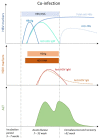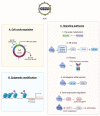HDV Pathogenesis: Unravelling Ariadne's Thread
- PMID: 33924806
- PMCID: PMC8145675
- DOI: 10.3390/v13050778
HDV Pathogenesis: Unravelling Ariadne's Thread
Abstract
Hepatitis Delta virus (HDV) lies in between satellite viruses and viroids, as its unique molecular characteristics and life cycle cannot categorize it according to the standard taxonomy norms for viruses. Being a satellite virus of hepatitis B virus (HBV), HDV requires HBV envelope glycoproteins for its infection cycle and its transmission. HDV pathogenesis varies and depends on the mode of HDV and HBV infection; a simultaneous HDV and HBV infection will lead to an acute hepatitis that will resolve spontaneously in the majority of patients, whereas an HDV super-infection of a chronic HBV carrier will mainly result in the establishment of a chronic HDV infection that may progress towards cirrhosis, liver decompensation, and hepatocellular carcinoma (HCC). With this review, we aim to unravel Ariadne's thread into the labyrinth of acute and chronic HDV infection pathogenesis and will provide insights into the complexity of this exciting topic by detailing the different players and mechanisms that shape the clinical outcome.
Keywords: HDV; HDV pathogenesis; acute HDV infection; chronic HDV infection; co-infection; hepatitis B virus HBV; hepatitis Delta virus; super-infection.
Conflict of interest statement
The authors declare no conflict of interest.
Figures







References
Publication types
MeSH terms
Substances
LinkOut - more resources
Full Text Sources
Other Literature Sources

